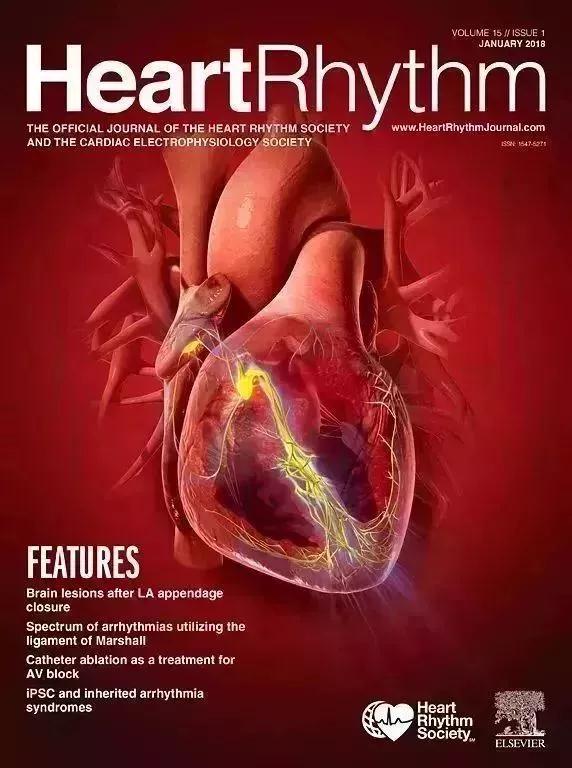<< First issue in January 2021 >>
Come and listen to the editor in chief to introduce the most authoritative international heart rhythm research results

Peng-Sheng Chen
The first original article is titled “Is Competitive Atrial Pacing a Possible Trigger for Atrial Fibrillation? Observations from the RATE Registry”. RATE, a multicenter registry, included 5379 patients with CIEDs followed for approximately 2 years. In 225 patients, 1394 episodes of both AT/AF and competitive atrial pacing were present in the same tracing. Competitive atrial pacing and AT/AF were strongly associated. The authors conclude that device-triggered AT/AF due to competitive atrial pacing is likely more common than previously recognized. This AT/AF entity differs from spontaneous AT/AF in duration and morphology. Clinical implications of spontaneous and device-triggered AT/AF may be different.
The next article is titled “Left ventricular summit arrhythmias with an abrupt V3 transition: Anatomy of the aortic interleaflet triangle vantage point”. Over a 3-year period, 78 consecutive patients with outflow tract ventricular arrhythmia were referred to the authors for mapping and ablation. Twenty patients (26%) exhibited an abrupt R-wave transition in lead V3 pattern, of whom 65% failed prior ablation. The authors found that an abrupt R-wave transition in lead V3 is a simple and distinct ECG pattern indicative of a site of origin from the septal margin of the LV summit. The right-left aortic interleaflet triangle vantage point was effective to eliminate this type of outflow tract ventricular arrhythmia that overwhelmingly exhibited the earliest activation from the epicardium or mid-myocardium. The authors also report 89% freedom from VT occurrence at one year.
Coming up next is “Clinical significance of myocardial scar in patients with frequent premature ventricular complexes undergoing catheter ablation”. A total of 351 consecutive patients with frequent PVCs referred for ablation were included. Cardiac magnetic resonance, or CMR was performed in all patients before the ablation procedure. The authors found that focal scar defined by CMR is independently associated with PVC-induced cardiomyopathy. Although ablation outcomes are worse in the presence of scarring, EF recovery can occur in most of these patients after ablation.
The next paper is “Premature Ventricular Complex Site of Origin and Ablation Outcomes in Patients with Prior Myocardial Infarction”. The authors studied 332 patients with frequent PVCs and left ventricular dysfunction. PVCs in post-MI patients originate predominantly from the MI scar and LV outflow track. PVC ablation significantly improves cardiac function and functional status in post-MI patients. A papillary muscle site of origin was found to be strongly associated with previous MI. These findings suggest that ablation may be beneficial in patients with MI, frequent PVCs and LV dysfunction.
Coming up next is “Impact of preoperative electrophysiological intervention on occurrence of peri/postoperative supraventricular tachycardia following Fontan surgery”. A total of 109 consecutive patients with a history of SVT before Fontan surgery were divided into 3 groups: 44 with EPS and catheter ablation; 21 with EPS without catheter ablation and 44 in whom EPS was not performed. There were 71 SVT incidences. The acute success rate of catheter ablation was 91%. No ablation or unsuccessful catheter ablation both significantly increased the risk of peri/postoperative SVT in multivariate analysis. The authors conclude that Preoperative catheter ablation reduces peri/postoperative SVT occurrence in Fontan surgery candidates at high risk for SVT.
The following article is “Unexpected high failure rate of a specific MicroPort/LivaNova/Sorin pacing lead”. A total of 585 leads were analyzed. Cumulative failure rate estimates were 5.2%, 6.3%, and 12.4% after 1, 2, and 3 years for the Beflex/Vega lead. This was worse compared to the reference lead. Electrical abnormalities such as noise oversensing and increased pacing thresholds became more frequent in the Beflex/Vega group. The authors conclude that the failure rate of the Beflex/Vega lead of >10% after 3 years was higher than that of a competitor lead. This gives rise to concern since >135,000 such leads are active worldwide.
Up next is “Risk of Arrhythmic Events Following Alcohol Septal Ablation for Hypertrophic Cardiomyopathy Using Continuous Implantable Cardiac Monitoring”. The authors enrolled 56 patients in this prospective study in which all patients received an implantable monitor (ICM). The Kaplan-Meier cumulative rate of ICM-detected arrhythmic events at 18 months of follow-up was 71%. The cumulative rate of the ICM-detected first atrial fibrillation event at 18 months was 37%, and the corresponding rate of complete heart block was 19%. The authors conclude that after alcohol septal ablation, ICM is effective in capturing clinically actionable arrhythmic events in patients with HCM regardless of patient's baseline risk factors.
The next one is “Global electrical heterogeneity associated with drug-induced torsades de pointes”. The authors analyzed ECG data from a case-control study of patients with a history of drug-induced TdP as well as age- and sex-matched controls. Vectorcardiograms were constructed from ECGs. Global electrical heterogeneity was then measured via the spatial ventricular gradient vector. They studied 17 cases with TdP and 17 controls. They found that the spatial ventricular gradient azimuth is correlated with a history of drug-induced TdP independent of QTc. Global electrical heterogeneity measurement may help identify patients at high risk for drug-induced arrhythmias.
Coming up is an article titled “Primary Prevention Implantable Cardioverter Defibrillators in Hypertrophic Cardiomyopathy. Are There Predictors of Appropriate Therapy?” The authors followed 302 patients for a mean 6.1 years. Among them, 38 (12.6%) received at least 1 appropriate ICD therapy. The authors conclude that the incidence of appropriate ICD therapies in patients with HCM and primary prevention ICDs is lower than previously reported. A high proportion of patients suffer from an ICD-related complication. Traditional risk factors have low predictive utility. Severe late gadolinium enhancement, atrial fibrillation, and young age are important predictors of ventricular tachyarrhythmias in HCM.
The next paper is “N-terminal pro-B-type natriuretic peptide is a specific predictor of appropriate device therapies in patients with primary prevention implantable cardioverter-defibrillators.” This was a prospective study of 342 stable patients with left ventricular ejection fraction ≤40% who received a primary prevention ICD. Median follow-up was 35.0 months. In unadjusted analyses, NT-proBNP predicted both appropriate ICD therapies and secondary outcomes including death, ICD-deactivation, chronic inotropic support and transplant). Multivariate analysis only reaffirmed the prediction of appropriate ICD therapies but not other outcomes, such as mortality. The authors conclude that NT-proBNP is a reasonable and specific predictor of future appropriate device therapies in primary prevention ICD recipients.
Coming up is “Computer versus Cardiologist: Is a machine learning algorithm able to outperform an expert in diagnosing phospholamban (PLN) p.Arg14del mutation on ECG?” A recurring deletion of arginine 14 in the regulatory domain of phospholamban causes dilated cardiomyopathy. The authors studied 155 adult phospholamban mutation carriers and 155 age- and sex-matched control subjects. Using machine learning, multiple models were developed to discriminate between these two groups. In terms of specificity, expert cardiologists outperformed all models. In terms of accuracy and sensitivity, experts were outperformed by all models. T-wave morphology was most important for classification of PLN p.Arg14del carriers. This study shows that machine learning can outperform experienced cardiologists in the diagnosis of phospholamban p.Arg14del cardiomyopathy and suggests that the shape of the T wave is of added importance to this diagnosis.
The next paper is “Sex-specific I KAS activation in rabbit ventricles with drug-induced QT prolongation”. IKAS stands for apamin sensitive small conductance calcium activated potassium current, which is known to have significant sex differences in rabbit hearts. The purpose of this study was to test the hypothesis that there is a sex difference in IKAS in the rabbit models of drugs induced LQTS in Langendorff-perfused rabbit hearts. The results showed that IKAS is abundantly increased in female but not in male ventricles with drug-induced LQTS. Increased IKAS helps preserve the repolarization reserve in female ventricles treated with IKs and IKr blockers or late sodium current activators.
Coming up next is “Simultaneous activation of the small conductance calcium activated potassium current by acetylcholine and inhibition of sodium current by ajmaline cause J-wave syndrome in Langendorff-perfused rabbit ventricles”. This study was also done in Langendorff perfused rabbit hearts using optical mapping and whole-cell voltage clamp techniques. The authors found that acetylcholine activates ventricular IKAS. Acetylcholine plus ajmaline induce J wave elevation and facilitate the induction of ventricular arrhythmias more in male than in female ventricles. The authors postulate that increased vagal tone at night may activate of IKAS in men to cause sudden death in patients with J wave syndrome.
The next paper is “Optical capture and defibrillation in rats with monocrotaline-induced myocardial fibrosis one year after a single intravenous injection of adeno-associated virus-channelrhodopsin-2”. Fifteen infant rats received jugular vein injection of adeno-associated virus (AAV). There was channelrhodopsin-2 expression throughout the ventricular myocardium 8 weeks after injection. Light could still trigger the corresponding ectopic heart rhythm, and the pulse width and illumination area could affect the light capture rate. VT/VF was induced successfully in 1-year-observation rats, and the rate of termination of VT/VF under light was much higher than that of spontaneous termination. The authors conclude that viral channelrhodopsin-2 transfection can play a long-term role in the rat heart, and light can successfully regulate heart rhythm and defibrillate after cardiac fibrosis.
Next up is “Electrical and structural remodeling contribute to atrial fibrillation in type 2 diabetic db/db mice”. The db/db mice have type 2 diabetes. The authors showed that the db/db mice were highly susceptible to AF in association with reduced atrial conduction velocity, action potential duration prolongation, and increased heterogeneity in repolarization in left and right atria. In db/db mice, atrial K+ currents, including the transient outward current (Ito) and the ultrarapid delayed rectifier current (IKur), were reduced. The authors conclude that increased susceptibility to AF in db/db mice occurs in association with impaired electrical conduction as well as electrical and structural remodeling of the atria.
These original articles were followed by a contemporary review titled “The rationale for repurposing funny current inhibition for management of ventricular arrhythmia”. The authors noted that ivabradine is known to exert effects on metabolism, ion homeostasis, and membrane electrophysiology of remodeled ventricular myocardium. This review considers novel concepts and evidence from clinical and experimental studies regarding this paradigm, with a potential role of ivabradine in ventricular arrhythmia.
Next up is a paper in the Creative Concept category, titled “Remote retrieval of automated external defibrillator data—Isn't it about time?” That paper is followed by a Viewpoint article titled “Back to the Future: Predicting Sudden Death in Hypertrophic Cardiomyopathy Relying on Individual Risk Markers and Physician Judgment Without Mathematical Scoring”.
The journal has two new initiatives. One is to publish a monthly paper to celebrate the 30 years of radiofrequency catheter ablation. The first one is written by Dr Melvin Scheinman titled“Every journey begins with the first step: reflections on the first catheter ablation in humans”.

